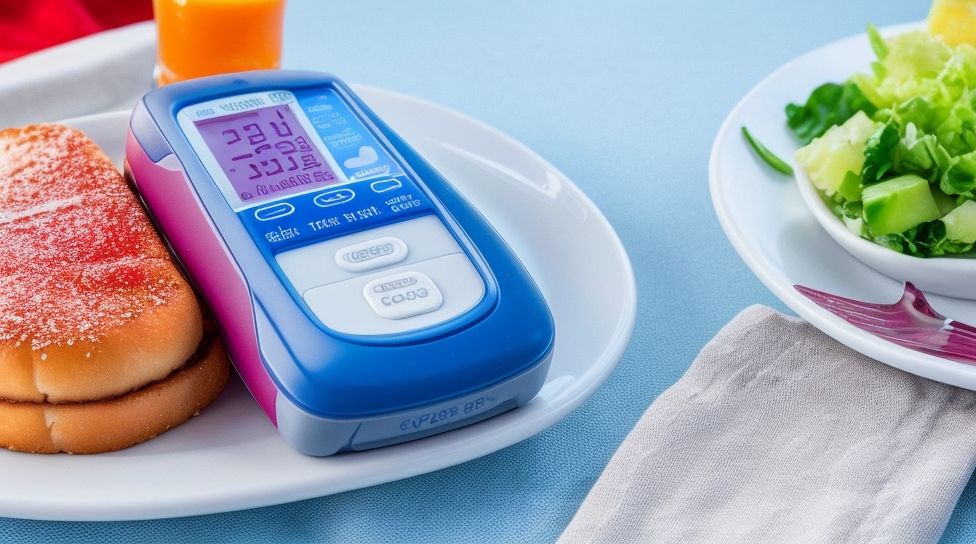Understanding the Glycemic Index for Effective Blood Sugar Control
The glycemic index (GI) is a valuable tool for managing blood sugar levels and promoting overall health. It measures how different carbohydrates in foods affect blood glucose levels and provides insights into the speed at which these carbohydrates are digested and absorbed by the body. Understanding the glycemic index is essential for individuals with conditions like diabetes or those aiming to maintain stable blood sugar levels.
To measure the glycemic index, foods are compared to a standard reference, usually glucose, with a value of 100. Foods with a high GI are rapidly digested and cause a rapid rise in blood sugar, while foods with a low GI are digested more slowly, resulting in a gradual and steady release of glucose into the bloodstream.
The glycemic index plays a crucial role in blood sugar management as it allows individuals to make informed food choices. By consuming foods with a low GI, blood sugar levels can be better regulated, reducing the risk of blood sugar spikes and crashes.
Various factors can influence the glycemic index of foods, including the type of carbohydrate present, the cooking time, and the degree of food processing. For instance, unrefined carbohydrates like whole grains generally have a lower GI compared to refined carbohydrates like white bread.
To effectively manage blood sugar levels using the glycemic index, it is important to choose low GI foods, combine foods to create a balanced glycemic response, and consider portion sizes. Opting for whole grains, legumes, and non-starchy vegetables can help stabilize blood sugar levels and minimize insulin spikes.
While the glycemic index offers several benefits in blood sugar management, it does have limitations. It does not account for the quantity of carbohydrates consumed or their overall impact on blood sugar levels, nor does it consider individual variations in glycemic response.
Incorporating the glycemic index into everyday life can be achieved by reading nutrition labels, planning meals, and seeking guidance from healthcare professionals or registered dietitians who specialize in blood sugar management. By using the glycemic index as a guide, individuals can make informed choices and take control of their blood sugar levels for enhanced overall health.
Key takeaway:
- Understanding the Glycemic Index: The glycemic index is a measure of how quickly carbohydrates in food raise blood sugar levels. It plays a crucial role in everyday blood sugar management.
- Using the Glycemic Index to Manage Blood Sugar Levels: One can choose low glycemic index foods, combine foods for balanced glycemic response, and consider portion sizes to manage blood sugar levels effectively.
- Practical Tips for Incorporating the Glycemic Index into Everyday Life: Reading nutrition labels, meal planning and preparation, and seeking professional guidance are practical ways to incorporate the glycemic index into daily routines for better blood sugar management.
Understanding the Glycemic Index

Photo Credits: Diabetescompass.Com by Samuel Hall
The Glycemic Index (GI) is a measure of how quickly carbohydrates in food raise blood sugar levels. Understanding the GI can help in managing blood sugar levels effectively. Here are key points to understand:
- Definition: The GI is a scale that ranks carbohydrates based on their effect on blood sugar levels compared to a reference food, typically glucose or white bread.
- Scale: The GI scale ranges from 0 to 100. Foods with a high GI (70 or above) cause a rapid spike in blood sugar levels, while those with a low GI (55 or below) have a more gradual impact.
- Factors: Several factors influence a food’s GI, including the type of carbohydrate, processing, cooking methods, and the presence of fiber and fat. Generally, foods with more fiber and fat tend to have a lower GI.
- Benefits: Understanding the GI can help individuals make informed food choices to manage blood sugar levels. Low GI foods provide a steady release of glucose, promoting stable energy levels and reducing the risk of insulin resistance and type 2 diabetes.
- Blood Sugar Management: Incorporating low GI foods into meals can help control blood sugar levels. Balancing high GI foods with low GI foods can slow down the absorption of glucose, preventing sharp spikes and crashes in blood sugar.
- Individual Variations: It’s important to note that individual responses to the GI can vary. Factors such as personal metabolism, other food components in a meal, and individual health conditions can influence blood sugar responses.
- Limitations: The GI should not be the sole factor in dietary decision-making. Considering overall nutritional value, portion sizes, and individual dietary needs is essential for a balanced and healthy diet.
- GI and Glycemic Load: The Glycemic Load (GL) takes into account both the GI and the amount of carbohydrates in a food serving. It provides a more complete picture of the overall impact on blood sugar levels.
- Practical Application: To incorporate the GI into everyday blood sugar management, focus on consuming whole grains, legumes, non-starchy vegetables, and fruits with a low to moderate GI. Pairing carbohydrates with protein, healthy fats, and fiber can further stabilize blood sugar levels.
- Consultation: Individuals with specific health conditions, such as diabetes, should consult with a healthcare professional or registered dietitian for personalized guidance on incorporating the GI into their dietary plans.
Understanding the GI can be a useful tool in making informed dietary choices and managing blood sugar levels for overall health and wellbeing.
How is the Glycemic Index Measured?

Photo Credits: Diabetescompass.Com by Harold Wilson
The Glycemic Index (GI) is a measure of how quickly carbohydrates in food raise blood sugar levels. To determine the GI value of a particular food, the following steps are involved:
- Selection of Test Food: A representative sample of the food to be tested is selected. It should be a typical portion size and prepared using standard cooking methods.
- Selection of Reference Food: A reference food, usually glucose or white bread, is chosen as a comparison standard. This food is assigned a GI value of 100.
- Recruitment of Participants: A group of healthy individuals is recruited to participate in the study. These participants consume the test food and reference food on separate occasions.
- Blood Glucose Measurement: Blood samples are taken from the participants before consuming the food and at specific intervals after eating. The blood glucose levels are measured using a blood glucose meter or laboratory analysis.
- Calculation of GI Value: The GI value is calculated by comparing the increase in blood glucose levels caused by the test food to the increase caused by the reference food. The ratio is expressed as a percentage.
- Statistical Analysis: The data collected from multiple participants are analyzed to determine the average GI value. Statistical methods are used to ensure accuracy and reliability.
- Assigning the GI Value: The calculated GI value is assigned to the tested food. It is categorized into one of three GI ranges: low (55 or less), medium (56-69), or high (70 or more).
- Publication and Database Entry: The GI value, along with other relevant information about the test food, is published in scientific journals and entered into databases for public access.
By measuring the GI of various foods, individuals can make informed dietary choices to manage their blood sugar levels effectively and maintain overall health.
Why is the Glycemic Index Important for Blood Sugar Management?

Photo Credits: Diabetescompass.Com by Jose Lewis
The Glycemic Index (GI) plays a crucial role in blood sugar management for the following reasons:
- Blood Sugar Control: The GI measures how quickly carbohydrates in food raise blood sugar levels. Foods with a high GI are rapidly digested and absorbed, causing a sharp increase in blood sugar. On the other hand, foods with a low GI are digested and absorbed more slowly, resulting in a gradual and steady rise in blood sugar levels. Understanding the GI can help individuals make informed choices to maintain stable blood sugar levels.
- Managing Diabetes: For individuals with diabetes, the GI is a valuable tool for managing blood sugar. By consuming foods with a low GI, they can avoid sudden spikes and drops in blood sugar levels, promoting better glycemic control. This can help reduce the risk of complications associated with diabetes.
- Sustained Energy: Foods with a low GI provide a slow and sustained release of glucose into the bloodstream, providing consistent energy levels. This is particularly beneficial for athletes, individuals with physically demanding jobs, and those seeking to maintain their energy levels throughout the day.
- Weight Management: High-GI foods can lead to rapid spikes in blood sugar levels, followed by a crash, which can trigger hunger and cravings. Incorporating low-GI foods into the diet can help promote satiety, control appetite, and support weight management efforts.
- Heart Health: High-GI diets have been associated with an increased risk of heart disease. By choosing foods with a low GI, individuals can reduce their intake of refined carbohydrates and added sugars, which are linked to negative cardiovascular outcomes.
- Overall Well-being: The GI can contribute to overall well-being by helping individuals make healthier food choices. A diet that focuses on low-GI foods, such as whole grains, fruits, vegetables, and lean proteins, provides essential nutrients, fiber, and antioxidants that support overall health and reduce the risk of chronic diseases.
By understanding and incorporating the principles of the GI into everyday food choices, individuals can better manage their blood sugar levels, promote overall health, and reduce the risk of various health conditions.
How Does the Glycemic Index Impact Blood Sugar Levels?
The impact of the glycemic index (GI) on blood sugar levels is significant. It measures how carbohydrates in foods affect the levels of sugar in the blood. High GI foods can cause a rapid increase in blood sugar levels, whereas low GI foods lead to a more gradual rise. Managing diabetes or maintaining stable blood sugar levels requires an understanding of this impact.
Consuming high GI foods can result in a spike in blood sugar, causing the body to release insulin to regulate the levels. With repeated spikes and increased production of insulin, there is a risk of developing insulin resistance and diabetes. On the other hand, low GI foods have a slower digestion and absorption rate, leading to a steadier rise in blood sugar levels.
To incorporate the glycemic index into everyday life, it is beneficial to choose low GI foods. These may include whole grains, legumes, non-starchy vegetables, and most fruits. Combining different foods can also help achieve a balanced glycemic response. For example, pairing high GI foods with protein or healthy fats can slow down the digestion process. However, it is crucial to consider portion sizes as even low GI foods can cause blood sugar spikes when consumed excessively.
While the glycemic index serves as a useful tool for blood sugar management, it does have its limitations. It is based on individual foods and does not consider the overall nutritional value of a meal. Factors such as cooking time and food processing can also impact the GI of foods.
Incorporating the glycemic index into everyday life requires reading nutrition labels, planning meals, and seeking guidance from professionals. Understanding how the glycemic index impacts blood sugar levels allows individuals to make informed choices about their diet, resulting in better blood sugar control.
Factors Affecting the Glycemic Index

Photo Credits: Diabetescompass.Com by Jason Lopez
When it comes to managing our blood sugar levels, understanding the factors that affect the glycemic index is crucial. In this section, we’ll dive into the key elements that can influence the glycemic index and ultimately impact our blood sugar. From the type of carbohydrate we consume to the cooking time and food processing methods involved, each sub-section will shed light on how these factors play a role in our everyday blood sugar management. So, let’s dig in and uncover the secrets behind maintaining stable blood sugar levels.
Type of Carbohydrate
Carbohydrates play a crucial role in blood sugar management. The type of carbohydrate consumed can significantly impact blood sugar levels. Different types of carbohydrates have varying effects on the body’s glycemic response.
Here is a table showcasing the different types of carbohydrates and their impact on blood sugar levels:
| Type of Carbohydrate | Glycemic Index |
| Highly processed carbohydrates (e.g., white bread, sugary cereals) | High |
| Simple carbohydrates (e.g., candy, soda) | High |
| Complex carbohydrates (e.g., whole grains, legumes) | Low to moderate |
| Fiber-rich carbohydrates (e.g., fruits, vegetables) | Low to moderate |
Consuming highly processed and simple carbohydrates can cause a rapid spike in blood sugar levels, leading to energy crashes and potential long-term health issues. On the other hand, complex carbohydrates and fiber-rich carbohydrates have a slower and steadier impact on blood sugar levels, promoting stable energy levels and overall health.
To manage blood sugar levels effectively, it is important to choose carbohydrates that have a low to moderate glycemic index. This includes opting for whole grains, legumes, fruits, and vegetables. Incorporating a variety of these carbohydrates into your diet can help maintain stable blood sugar levels and support overall well-being.
In summary, the type of carbohydrate consumed can greatly influence blood sugar levels. Choosing low to moderate glycemic index carbohydrates such as whole grains, legumes, fruits, and vegetables can contribute to better blood sugar management. Make mindful choices when it comes to carbohydrates to support your health goals.
Why spend hours in the kitchen when you can manage your blood sugar with just a little cooking time consideration?
Cooking Time
Cooking time plays a crucial role in determining the glycemic index (GI) of food. Follow these steps to effectively manage blood sugar levels during cooking:
- Opt for shorter cooking time for carbohydrates: When cooking carbohydrates like pasta, rice, or potatoes, make sure not to overcook them. Prolonged cooking can cause the carbohydrates to break down into smaller particles, resulting in a higher GI.
- Choose cooking methods that preserve nutrients: Steaming, boiling, or microwaving are excellent cooking methods that help maintain the structure and composition of carbohydrates. These techniques minimize the breakdown of carbohydrates, keeping the GI lower.
- Avoid high-temperature cooking: High-temperature cooking methods such as frying or grilling can lead to the formation of advanced glycation end products (AGEs). These compounds are associated with increased insulin resistance and higher GI values.
- Be mindful of cooking time for grains and legumes: When cooking grains and legumes like quinoa, lentils, or beans, follow the recommended cooking times. Overcooking can raise their GI, while undercooking may make them difficult to digest.
- Consider the ripeness of fruits: The ripeness level of fruits can affect their GI. Ripe fruits generally have higher GI values compared to unripe ones. Opt for slightly unripe fruits to help manage blood sugar levels.
By carefully considering cooking time and methods, you can effectively control the glycemic index of your meals and maintain stable blood sugar levels. Remember to combine these cooking techniques with other strategies, such as choosing low GI foods and practicing portion control, for effective blood sugar management.
Food processing can turn a healthy carbohydrate into a blood sugar roller coaster ride.
Food Processing
Food processing plays a significant role in determining the glycemic index of a food. The table below illustrates the impact of different food processing methods on the glycemic index.
| Food Processing Method | Glycemic Index Effect |
| Whole Grain | Low Glycemic Index |
| Milling | Increases Glycemic Index |
| Pulverizing | Increases Glycemic Index |
| Refining | Increases Glycemic Index |
| Cooking Time | Decreases Glycemic Index (longer cooking time) |
| Canning | Increases Glycemic Index |
| Freezing | No Impact on Glycemic Index |
Food processing can affect the glycemic index in several ways. Milling, pulverizing, and refining break down the structure of carbohydrates, making them more easily digested and increasing their glycemic index. On the other hand, longer cooking times can reduce the glycemic index by breaking down complex carbohydrates into simpler forms. Canning can raise the glycemic index as it involves preserving food in a sugary liquid. Freezing has no impact on the glycemic index as it does not affect the carbohydrate structure.
It is important to consider food processing methods when choosing foods for blood sugar management. Opting for whole grains and foods with minimal processing can help maintain stable blood sugar levels. Considering cooking times and choosing cooking methods that promote slower carbohydrate digestion can also be beneficial.
Using the Glycemic Index to Manage Blood Sugar Levels

Photo Credits: Diabetescompass.Com by Michael Rodriguez
Discover how the glycemic index can be your guide to effectively managing blood sugar levels. Dive into the world of choosing low glycemic index foods, learning how to combine them for a balanced glycemic response, and consider the importance of portion sizes. Stay in control of your blood sugar and unlock the key to a healthier lifestyle.
Choosing Low Glycemic Index Foods
- Choosing low glycemic index foods is essential for maintaining stable blood sugar levels. Opt for whole grains like whole wheat bread, brown rice, and whole grain pasta, as they have a lower glycemic index compared to refined grains.
- Including legumes in your diet is another smart choice. Foods like beans, lentils, and chickpeas are low glycemic index foods that provide both fiber and protein, making them highly nutritious.
- Prioritizing non-starchy vegetables such as broccoli, leafy greens, and peppers is also recommended. These vegetables have a minimal impact on blood sugar levels due to their high fiber and water content.
- When it comes to protein, opt for lean sources like poultry, fish, tofu, and low-fat dairy products. These foods can help stabilize blood sugar levels while also providing necessary nutrients.
- It’s important to include healthy fats in your diet as well. Foods like avocados, nuts, and olive oil are rich in healthy fats and can slow down the digestion of carbohydrates, resulting in a lower glycemic response.
- Avoiding sugary beverages is crucial. Instead of soda or fruit juices with a high glycemic index, choose water, unsweetened tea, or sparkling water for better blood sugar control.
- Limiting processed foods is another key recommendation. These foods often contain added sugars and refined carbohydrates, which lead to a higher glycemic response. Opt for whole, unprocessed foods whenever possible.
Combining Foods for Balanced Glycemic Response
To achieve a balanced glycemic response, it is important to naturally combine foods in your meals. By incorporating certain food combinations, you can effectively slow down the digestion and absorption of carbohydrates, resulting in a gradual increase in blood sugar levels.
One effective way to achieve a balanced glycemic response is to combine carbohydrates with sources of protein and healthy fats. For instance, instead of having a plain bagel for breakfast, you can enhance it by adding some peanut butter or avocado, which are excellent sources of protein and healthy fats. This addition will help in slowing down the release of glucose into your bloodstream, preventing a sudden spike in blood sugar levels.
Including fiber-rich foods in your meals is another smart strategy. Fiber takes more time to digest and aids in slowing down the absorption of carbohydrates. Whole grains, vegetables, and legumes are all excellent sources of fiber. As an example, you can opt for pairing brown rice with grilled chicken and steamed broccoli to achieve a balanced glycemic response.
Another helpful tip is to have smaller, more frequent meals throughout the day. This practice aids in maintaining stable blood sugar levels as it allows for better regulation of glucose absorption and utilization by the body.
By naturally combining foods for a balanced glycemic response, you can effectively prevent sudden spikes and crashes in your blood sugar levels. This is particularly advantageous for individuals with diabetes or those who want to optimize their blood sugar management.
Portion control is key to managing blood sugar levels, so remember: a serving of chips is not just one potato chip, unfortunately.
Considering Portion Sizes
When it comes to managing blood sugar levels using the glycemic index, it is crucial to consider portion sizes.
The Potential Benefits and Limitations of Using the Glycemic Index

Photo Credits: Diabetescompass.Com by Anthony Torres
Discover the power of the Glycemic Index in managing blood sugar levels! Uncover the potential benefits and limitations of using this valuable tool. From understanding how the Glycemic Index benefits our dietary choices to recognizing its limitations, we’ll explore the ins and outs of this fascinating concept. Get ready to enhance your knowledge of blood sugar management and gain insights into the effectiveness of the Glycemic Index in everyday life.
Benefits of Using the Glycemic Index
Using the Glycemic Index to manage blood sugar levels effectively offers several benefits:
- Improved blood sugar control: By incorporating foods with a low glycemic index, individuals can maintain stable blood sugar levels, preventing sudden spikes and crashes. This is especially advantageous for individuals with diabetes or those at risk of developing it.
- Sustained energy levels: Low glycemic index foods are digested and absorbed slowly, gradually releasing energy. This steady energy release helps prevent fatigue and promotes sustained energy levels throughout the day.
- Weight management: Foods with a low glycemic index are generally rich in fiber and have a higher satiety factor, which keeps individuals feeling full for longer periods. This aids in weight management by reducing overall calorie intake and preventing overeating.
- Reduced risk of chronic diseases: Incorporating low glycemic index foods into the diet has been linked to a lower risk of chronic conditions such as heart disease, certain cancers, and obesity.
- Enhanced athletic performance: Athletes can benefit from consuming foods with a moderate to high glycemic index before exercise as they provide quick energy and improve performance. Consuming low glycemic index foods after a workout helps with muscle recovery and replenishing glycogen levels.
It’s important to note that responses to the glycemic index can vary among individuals. Factors like portion sizes, food combinations, and overall dietary patterns also contribute to blood sugar management. For personalized guidance on incorporating the glycemic index into your everyday life, consulting with a healthcare professional or registered dietitian is recommended.
Limitations of the Glycemic Index
When utilizing the Glycemic Index as a tool for blood sugar management, it is crucial to take into account the limitations associated with it.
|
Therefore, when utilizing the Glycemic Index, it is crucial to consider these limitations. Additionally, it is recommended to regularly monitor blood sugar levels, seek guidance from healthcare professionals, and personalize dietary choices based on individual responses.
From reading labels to seeking guidance, practical tips for incorporating the glycemic index into everyday life can help you navigate the sugary seas of blood sugar management.
Practical Tips for Incorporating the Glycemic Index into Everyday Life

Photo Credits: Diabetescompass.Com by Alan Gonzalez
Looking to manage your blood sugar levels effectively on a daily basis? Dive into practical tips that incorporate the glycemic index seamlessly into your everyday life. From decoding nutrition labels to mastering meal planning and preparation, we’ve got you covered. Plus, discover the importance of seeking professional guidance to optimize your blood sugar management journey. Get ready to take charge of your health and make informed choices with these valuable insights.
Reading Nutrition Labels
Reading nutrition labels is crucial for effectively managing blood sugar levels. It empowers you to make informed choices about the foods you consume and comprehend their impact on your body. Here are some key considerations when reading nutrition labels:
- Pay attention to the serving size listed on the label, as all the information provided is based on that specific serving size.
- Focus on the total carbohydrates, including both sugars and fiber, listed on the label. It is important to carefully monitor your carbohydrate intake if you are managing blood sugar levels.
- Take note of the amount of added sugars in the product. Limiting added sugars is essential to prevent spikes in blood sugar levels.
- Check the dietary fiber content to gauge its ability to slow down carbohydrate absorption and stabilize blood sugar levels.
- Although not always mentioned on nutrition labels, being aware of the glycemic index of foods can aid in making healthier choices. Foods with a low glycemic index have a gentler impact on blood sugar levels.
By incorporating reading nutrition labels into your routine and comprehending the provided information, you can make more informed decisions about the foods you consume. This will ultimately help you effectively manage your blood sugar levels and improve your overall health.
Meal Planning and Preparing
1. Assess your current eating habits and identify areas for enhancement through meal planning and preparing.
2. Establish specific objectives for your meal planning, such as incorporating more low glycemic index foods or reducing portion sizes, thereby improving your overall diet.
3. Formulate a comprehensive weekly meal plan encompassing breakfast, lunch, dinner, and snacks.
4. Opt for recipes and food options that rank low on the glycemic index scale, such as whole grains, lean proteins, and vegetables.
5. Compile a detailed grocery list based on your meal plan to ensure you have all the essential ingredients required.
6. Allocate dedicated time for meal preparation, whether it is batch cooking or prepping ingredients in advance.
7. Cook and portion out meals in advance, granting easy accessibility throughout the entire week.
8. Employ portion control tools like measuring cups or a food scale to ensure you adhere to appropriate serving sizes.
9. Ensure each meal includes a well-balanced combination of macronutrients, particularly focusing on low glycemic index carbohydrates, alongside proteins and healthy fats.
10. Continuously monitor and track your progress to evaluate the effectiveness of your meal planning and preparing, making necessary adjustments when needed.
Fact: Numerous studies have demonstrated that engaging in meal planning and preparing can significantly enhance dietary choices, foster healthier eating habits, and effectively manage blood sugar levels.
Seeking Professional Guidance
Seeking professional guidance is crucial when it comes to effectively managing blood sugar levels. It is essential to consult with a healthcare professional, such as a registered dietitian or endocrinologist, who can offer valuable expertise and personalized advice based on individual needs. These professionals can assist in creating a customized meal plan that considers specific dietary requirements and preferences. They may recommend incorporating low glycemic index foods into the plan to promote stable blood sugar levels, provide guidance on portion control, and educate on reading nutrition labels and understanding glycemic index values. Seeking professional guidance ensures that individuals receive accurate and evidence-based information to make informed decisions about their dietary choices. Moreover, it allows for continuous monitoring, accountability, and adjustment of the blood sugar management plan, as required. By collaborating with a healthcare professional, individuals can enhance their proficiency in managing blood sugar levels and cultivate an overall healthier lifestyle.
The Glycemic Index: Its Role in Everyday Blood Sugar Management
- ✅ The Glycemic Index (GI) ranks carbohydrate-based foods and drinks based on how quickly they raise blood glucose levels. (Source: Diabetes.org.uk)
- ✅ Low-GI foods with a rating of 55 or below can help manage long-term blood glucose levels in people with type 2 diabetes. (Source: Diabetes.org.uk)
- ✅ Combining foods with different GIs can alter the overall GI of a meal, allowing better blood sugar control. (Source: Diabetes.org.uk)
- ✅ High-GI foods can make it harder for people with diabetes to control their blood sugar levels. (Source: MedlinePlus)
- ✅ Balanced blood sugar management involves choosing low to medium GI foods and considering portion sizes and carbohydrate content. (Source: MedlinePlus)
Frequently Asked Questions
What is the glycemic index (GI) and how does it affect blood sugar levels?
The glycemic index (GI) is a ranking of how quickly carbohydrate-based foods and drinks raise blood glucose levels. It is a useful tool for managing diabetes, as different carbohydrates are digested and absorbed at different rates. Foods with a low GI rating are slowly absorbed, while high GI foods increase blood glucose quickly. It is important to choose low-GI options with each meal or snack, but also consider portion sizes and the total amount of carbohydrates consumed.
Can the glycemic index be used to manage blood sugar levels in people with type 2 diabetes?
Yes, research shows that choosing low-GI foods can help manage long-term blood glucose levels in people with type 2 diabetes. Low-GI options include fruits, vegetables, unsweetened milk, nuts, pulses, and some wholegrain cereals and bread. However, it is not recommended to solely focus on GI, as it could lead to an unbalanced diet that is high in fat and calories. It is important to consider the bigger picture and choose foods high in fiber and wholegrains, while being low in saturated fat, salt, and sugar.
What are some examples of low glycemic index (GI) foods?
Some examples of low GI foods include bulgar, barley, pasta, parboiled rice, quinoa, high-fiber bran cereal, oatmeal, non-starchy vegetables, fruits, nuts, legumes, beans, milk, and yogurt. These foods are slowly absorbed and help control blood sugar levels. Additionally, whole foods generally have a lower GI than processed foods.
Should I include low-glycemic index (GI) alternatives in my diet?
Yes, including low-GI alternatives in your diet can be beneficial for managing blood sugar levels. Low-GI options are slowly absorbed and provide a more sustained release of glucose in the body. This can help to avoid fluctuations in blood sugar and promote better glycemic control. When planning meals, it is recommended to choose foods with a low to medium GI and also consider portion sizes and overall carbohydrate content.
Can the glycemic index (GI) play a role in weight loss and dietary prevention?
Yes, the glycemic index can play a role in weight loss and dietary prevention. Low-GI foods can help control blood sugar, which may aid in weight loss efforts. These foods tend to be more filling and can help regulate appetite. Additionally, incorporating low-GI foods into the diet can contribute to a healthier overall eating pattern, which may reduce the risk of conditions such as cardiovascular disease and type 2 diabetes.
Can genetic factors affect how the glycemic index (GI) impacts blood sugar?
Yes, genetic factors can affect how the glycemic index impacts blood sugar. Individual variations in glucose metabolism and insulin sensitivity can influence how the body responds to different carbohydrates. It is important for individuals to work with their healthcare provider and consider their individual needs and medical history when managing blood sugar levels through dietary management.






